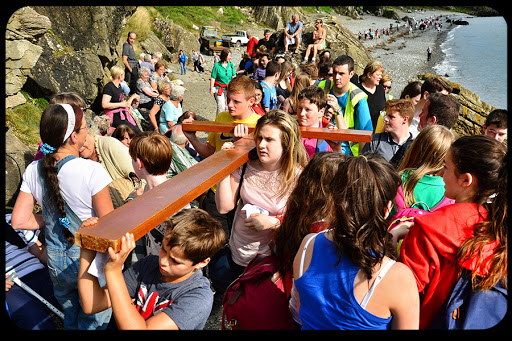I want to point out a minor mystery about religious behavior and practice, and one to which I have no ready answer. Briefly, why does the United States have no great pilgrimage centers, comparable to Lourdes or Fátima?
By any standard measure, the United States is a much more religious society than most of Europe. Church attendance figures are far higher, and religious institutions occupy a far greater role in public life. It is Europe, though, that over the past quarter century has witnessed a massive revival in pilgrimage. Historic pilgrim shrines like Compostela have experienced huge growth in numbers, and whole new centers like Medjugorje have appeared. Below the level of such celebrity sites, dozens of lesser centers thrive.
Apart from the actual destinations, pilgrim trails and pathways are now widely recognized and actively promoted by tourist authorities as well as churches, and that is as true of Protestant areas as well as Catholic and Orthodox. Across Western Europe, you find landmarks indicating the ancient St. James’s Way, and the Via Francigena. Even secular Scandinivia now has its hugely popular Olav Pilgrim Trail, to the ancient shrine at Nidaros (Trondheim). Of course, it is very hard to distinguish between religious and secular motives driving such pilgrims, and many are assuredly tourists and hikers rather than religious seekers. But was that not also true in Chaucer’s day?
Anyone even slightly aware of religious matters can point to a dozen European shrines and churches that attract large numbers of pilgrims. But what about the United States, home to perhaps seventy million Catholics? Could anyone not deeply steeped in Catholic culture point to a celebrated U.S. shrine like those of Europe or Brazil? And most of those so learned tend to the older and more traditional side of the church spectrum. Could most younger Catholics come up with such names?
I can point to many local and regional American shrines, perhaps forty or fifty in all, and some enormously popular. For South-Western Catholics, for instance, few places compete in holiness with the Santuario at Chimayo in New Mexico. Maryland has the national shrine of the Virgin Mary, at Emmitsburg, near to the home of St. Elizabeth Seton. New York state has the national shrine of the astonishing Mohawk saint, Kateri Tekawitha – but again, how many ordinary believers could tell you where it was?
Particular churches, cathedral and religious houses have established shrines and encouraged pilgrimages, but with no disrespect to such places, few indeed have any reputation far beyond their own states, or indeed their immediate localities. Many are strictly targeted at particular ethnic communities, as with the Polish-oriented shrine of Our Lady of Czestochowa in Doylestown, Pennsylvania. Moreover, an unscientific observation suggests that the visitors to such local shrines are not large in number, and they tend to an older demographic. The main exception is Emmitsburg, which draws heavily from the various newer ethnic communities concentrated in such numbers on the East Coast. In recent years, for instance, Vietnamese Catholics have turned out to Emmitsburg in their thousands to celebrate the Virgin of La Vang. But these are, as I say, exceptions. In commercial terms, the appeal is strictly directed to a niche market.
I repeat my original question. Why has the U.S. never created a legendary national shrine to compete with European or Latin American centers? More tellingly, why has the U.S. not enjoyed the kind of sweeping popular revival of pilgrim travel that has been such a prominent part of European religious life just since the 1990s? Or, dare we hope that we are simply witnessing a time lag, and American pilgrim trails might soon be as jammed as their European counterparts?
Philip Jenkins is a Distinguished Professor of History at Baylor University and author of The Great and Holy War: How World War I Became a Religious Crusade.

